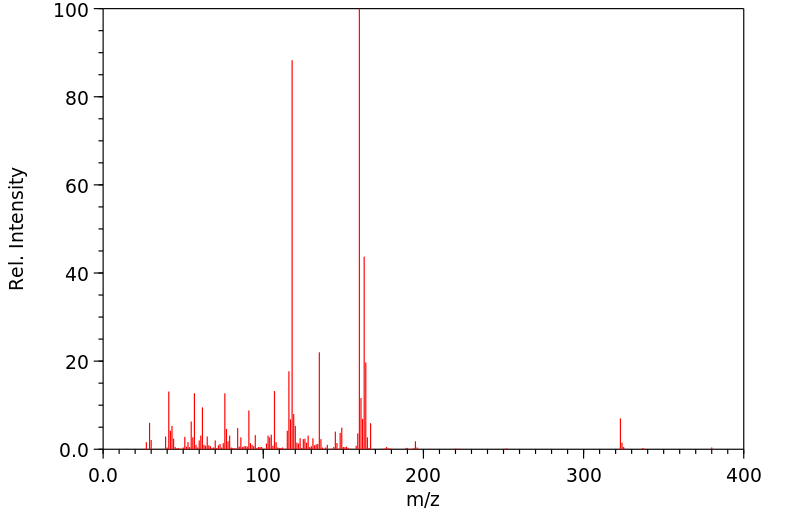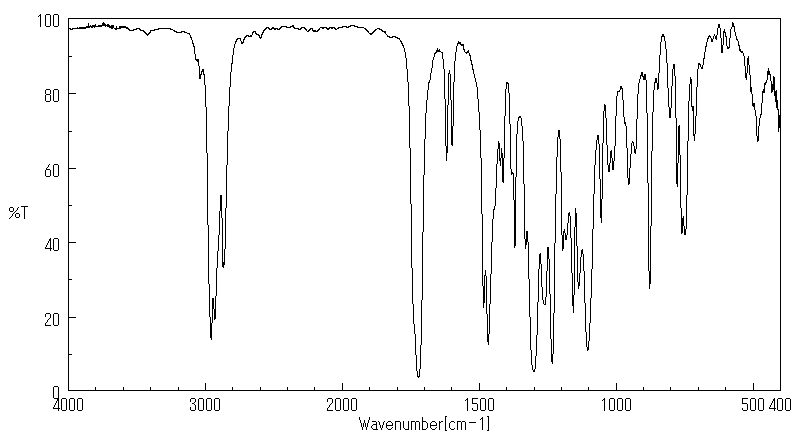丁硫克百威 | 55285-14-8
中文名称
丁硫克百威
中文别名
好安威;丁呋丹;2,3-二氢-2,2-二甲基-7-苯并呋喃-N-(2-正丁氨基硫基)-N-甲基氨基甲酸酯;丁硫威;2,3-二氢-2,2-二甲基苯并呋喃-7-基(二丁基氨基硫)甲基氨基甲酸酯;2,3-二氢-2,2-二甲基苯并呋喃-7-基(二丁基氨基硫)N-甲基氨基甲酸酯
英文名称
carbosulfan
英文别名
(2,2-dimethyl-3H-1-benzofuran-7-yl) N-(dibutylamino)sulfanyl-N-methylcarbamate;2,3-dihydro-2,2-dimethyl-7-benzofuranyl (dibutylaminothio)methylcarbamate;Advantage
CAS
55285-14-8
化学式
C20H32N2O3S
mdl
MFCD00128058
分子量
380.552
InChiKey
JLQUFIHWVLZVTJ-UHFFFAOYSA-N
BEILSTEIN
——
EINECS
——
-
物化性质
-
计算性质
-
ADMET
-
安全信息
-
SDS
-
制备方法与用途
-
上下游信息
-
文献信息
-
表征谱图
-
同类化合物
-
相关功能分类
-
相关结构分类
物化性质
-
稳定性/保质期:
如果按照规定使用和储存,则不会分解,且没有已知的危险反应。
计算性质
-
辛醇/水分配系数(LogP):5.7
-
重原子数:26
-
可旋转键数:10
-
环数:2.0
-
sp3杂化的碳原子比例:0.65
-
拓扑面积:67.3
-
氢给体数:0
-
氢受体数:5
ADMET
代谢
Carbosulfan has known human metabolites that include dibutyl(sulfanyl)amine, (2,2-dimethyl-3H-1-benzofuran-7-yl) N-dibutylsulfinamoyl-N-methylcarbamate, and Carbofuran.
来源:NORMAN Suspect List Exchange
代谢
The carbamates are hydrolyzed enzymatically by the liver; degradation products are excreted by the kidneys and the liver. (L793)
来源:Toxin and Toxin Target Database (T3DB)
毒理性
碳硫磷是一种胆碱酯酶或乙酰胆碱酯酶(AChE)抑制剂。碳酰胺通过羧基化酶的活性位点与胆碱酯酶形成不稳定的络合物。这种抑制作用是可逆的。胆碱酯酶抑制剂抑制乙酰胆碱酯酶的作用。由于其基本功能,干扰乙酰胆碱酯酶作用的化学物质是强效的神经毒素,即使在低剂量下也会导致过度流涎和流泪。在更高水平的暴露下,头痛、流涎、恶心、呕吐、腹痛和腹泻常常很明显。乙酰胆碱酯酶分解神经递质乙酰胆碱,后者在神经和肌肉接点处释放,以使肌肉或器官放松。乙酰胆碱酯酶抑制的结果是乙酰胆碱积聚并继续发挥作用,使得任何神经冲动不断传递,肌肉收缩不会停止。
Carbosulfan is a cholinesterase or acetylcholinesterase (AChE) inhibitor. Carbamates form unstable complexes with chlolinesterases by carbamoylation of the active sites of the enzymes. This inhibition is reversible. A cholinesterase inhibitor suppresses the action of acetylcholine esterase. Because of its essential function, chemicals that interfere with the action of acetylcholine esterase are potent neurotoxins, causing excessive salivation and eye-watering in low doses. Headache, salivation, nausea, vomiting, abdominal pain and diarrhea are often prominent at higher levels of exposure. Acetylcholine esterase breaks down the neurotransmitter acetylcholine, which is released at nerve and muscle junctions, in order to allow the muscle or organ to relax. The result of acetylcholine esterase inhibition is that acetylcholine builds up and continues to act so that any nerve impulses are continually transmitted and muscle contractions do not stop.
来源:Toxin and Toxin Target Database (T3DB)
毒理性
对人类无致癌性(未列入国际癌症研究机构IARC清单)。
No indication of carcinogenicity to humans (not listed by IARC).
来源:Toxin and Toxin Target Database (T3DB)
毒理性
急性暴露于胆碱酯酶抑制剂可能会导致胆碱能危象,表现为严重的恶心/呕吐、流涎、出汗、心动过缓、低血压、崩溃和抽搐。肌肉无力可能性增加,如果呼吸肌受累,可能会导致死亡。在运动神经积累乙酰胆碱会导致神经肌肉接头处尼古丁受体的过度刺激。当这种情况发生时,可以看到肌肉无力、疲劳、肌肉痉挛、肌束颤动和麻痹等症状。当自主神经节积累乙酰胆碱时,这会导致交感系统中尼古丁受体的过度刺激。与此相关的症状是高血压和低血糖。由于乙酰胆碱积累,中枢神经系统中尼古丁乙酰胆碱受体的过度刺激会导致焦虑、头痛、抽搐、共济失调、呼吸和循环抑制、震颤、全身无力,甚至可能昏迷。当由于乙酰胆碱过多而在毒蕈碱乙酰胆碱受体上表达毒蕈碱过度刺激时,可能会出现视力障碍、胸部紧绷、由于支气管收缩引起的喘息、支气管分泌物增加、唾液分泌增加、流泪、出汗、肠蠕动和排尿等症状。长期高(>10年)暴露会导致神经心理学后果,包括感知和视动处理障碍(A15321)。
Acute exposure to cholinesterase inhibitors can cause a cholinergic crisis characterized by severe nausea/vomiting, salivation, sweating, bradycardia, hypotension, collapse, and convulsions. Increasing muscle weakness is a possibility and may result in death if respiratory muscles are involved. Accumulation of ACh at motor nerves causes overstimulation of nicotinic expression at the neuromuscular junction. When this occurs symptoms such as muscle weakness, fatigue, muscle cramps, fasciculation, and paralysis can be seen. When there is an accumulation of ACh at autonomic ganglia this causes overstimulation of nicotinic expression in the sympathetic system. Symptoms associated with this are hypertension, and hypoglycemia. Overstimulation of nicotinic acetylcholine receptors in the central nervous system, due to accumulation of ACh, results in anxiety, headache, convulsions, ataxia, depression of respiration and circulation, tremor, general weakness, and potentially coma. When there is expression of muscarinic overstimulation due to excess acetylcholine at muscarinic acetylcholine receptors symptoms of visual disturbances, tightness in chest, wheezing due to bronchoconstriction, increased bronchial secretions, increased salivation, lacrimation, sweating, peristalsis, and urination can occur. Chronically high (>10 years) exposure leads to neuropsychological consequences including disturbances in perception and visuo-motor processing (A15321).
来源:Toxin and Toxin Target Database (T3DB)
毒理性
吸入(L793);口服(L793);皮肤给药(L793)
Inhalation (L793) ; oral (L793); dermal (L793)
来源:Toxin and Toxin Target Database (T3DB)
毒理性
与有机磷化合物一样,症状和体征基于过度的胆碱能刺激。与有机磷中毒不同,氨基甲酸酯中毒的持续时间往往较短,因为神经组织乙酰胆碱酯酶的抑制作用是可逆的,而且氨基甲酸酯的代谢速度更快。肌肉无力、眩晕、出汗和轻微的身体不适是常见的早期症状。头痛、流涎、恶心、呕吐、腹痛和腹泻在较高暴露水平时常常很明显。瞳孔收缩伴有视力模糊、不协调、肌肉抽搐和言语不清也有报道。(L795)
As with organophosphates, the signs and symptoms are based on excessive cholinergic stimulation. Unlike organophosphate poisoning, carbamate poisonings tend to be of shorter duration because the inhibition of nervous tissue acetylcholinesterase is reversible, and carbamates are more rapidly metabolized. Muscle weakness, dizziness, sweating and slight body discomfort are commonly reported early symptoms. Headache, salivation, nausea, vomiting, abdominal pain and diarrhea are often prominent at higher levels of exposure. Contraction of the pupils with blurred vision, incoordination, muscle twitching and slurred speech have been reported. (L795)
来源:Toxin and Toxin Target Database (T3DB)
安全信息
-
储存条件:密封存储,并在 0-6 ºC 下保存。
制备方法与用途
制备方法
二正丁氨基氯化硫的制备
加入二正丁胺和石油醚(60~90℃),搅拌冷却至0℃,然后缓慢滴加二氯化二硫,维持温度在0~10℃。反应2小时后,二正丁胺、二氯化二硫与硫酰氯的比例为1:0.6:0.55(摩尔比),收率为88%。
丁硫克百威的合成将上述制得的二正丁氨基氯化硫与克百威按1:1比例反应,并加入适量碱液调节反应温度至10~20℃。反应持续2小时,之后加水搅拌10分钟,过滤得到未反应完的克百威可回收利用。滤液分层后减压脱溶,收率为90%。
制备方法二中间体羟基化合物的合成方法详见克百威文献。此外,也有报道通过环己酮和异丁醛出发,依次经过叉醇醛缩合、氯化反应、芳环化反应、水解反应和闭环反应五步合成得到该中间体。其独特之处在于从非芳香族化合物开始合成,是一种选择性极高的合成路线。
合成制备方法 制备方法一-
二正丁氨基氯化硫的制备:加入二正丁胺和石油醚(60~90℃),搅拌冷却至0℃,随后缓慢滴加二氯化二硫,在0~10℃条件下保温反应2小时。此过程二正丁胺、二氯化二硫与硫酰氯的比例为1:0.6:0.55(摩尔比),最终收率为88%。
-
丁硫克百威的合成:将制得的二正丁氨基氯化硫与克百威按1:1比例反应,过程中加入适量碱液以调控温度至10~20℃。反应进行2小时后加水搅拌10分钟,过滤分离未反应完全的克百威,该部分可回收使用。滤出的液体分层后减压脱溶处理,最终收率为90%。
-
制备方法二:中间体羟基化合物的合成方式见克百威相关文献。另有文献报道了一种由环己酮和异丁醛出发,经历叉醇醛缩合、氯化反应、芳环化反应、水解反应及闭环反应五步合成得到该化合物的过程。其特别之处在于利用非芳香族化合物进行合成,具有极高的选择性。
上下游信息
-
上游原料
中文名称 英文名称 CAS号 化学式 分子量 克百威 2,3-dihydro-2,2-dimethyl-7-benzofuranol methylcarbamate 1563-66-2 C12H15NO3 221.256 -
下游产品
中文名称 英文名称 CAS号 化学式 分子量 —— (2,2-dimethyl-3H-1-benzofuran-7-yl) N-dibutylsulfinamoyl-N-methylcarbamate 1260117-81-4 C20H32N2O4S 396.551 —— 2,3-dihydro-2,2-dimethyl-7-benzofuranyl (methoxysulfenyl)(methyl)carbamate 86627-62-5 C13H17NO4S 283.348 —— Carbamic acid, (ethoxythio)methyl-, 2,3-dihydro-2,2-dimethyl-7-benzofuranyl ester 86627-63-6 C14H19NO4S 297.37 克百威 2,3-dihydro-2,2-dimethyl-7-benzofuranol methylcarbamate 1563-66-2 C12H15NO3 221.256 3-羟基呋喃丹 3-Hydroxycarbofuran 16655-82-6 C12H15NO4 237.255 3-酮呋喃丹 2,3-dihydro-3-oxo-2,2-dimethylbenzofuran-7-yl methylcarbamate 16709-30-1 C12H13NO4 235.24 呋喃酚 2,3-dihydro-2,2-dimethylbenzofuran-7-ol 1563-38-8 C10H12O2 164.204 7-羟基-2,2-二甲基-3(2H)-苯并呋喃酮 2,3-dihydro-2,2-dimethyl-3-oxobenzofuran-7-ol 17781-16-7 C10H10O3 178.188 3-羟基呋喃丹-7-酚 2,3-dihydro-3-hydroxy-2,2-dimethylbenzofuran-7-ol 17781-15-6 C10H12O3 180.203
反应信息
-
作为反应物:参考文献:名称:Abd El-Aleem; Abu-Zahw; Abd-Allah, Egyptian Journal of Chemistry, 2009, vol. 52, # 2, p. 217 - 231摘要:DOI:
-
作为产物:参考文献:名称:Trialkylamine/sulfur dioxide catalyzed sulfenylation of carbamates摘要:披露了一种改进的工艺,用于在溶剂和碱的存在下对碳酸酯进行亚磺酰化,其中在碳酸酯和亚磺酰卤化物的反应中,在较低烷基胺和二氧化硫的络合物的催化量存在下进行。公开了几种制备和利用该络合物进行反应的方法,并给出了示例。公开号:US04329293A1
文献信息
-
[EN] ACC INHIBITORS AND USES THEREOF<br/>[FR] INHIBITEURS DE L'ACC ET UTILISATIONS ASSOCIÉES
-
[EN] BICYCLYL-SUBSTITUTED ISOTHIAZOLINE COMPOUNDS<br/>[FR] COMPOSÉS ISOTHIAZOLINE SUBSTITUÉS PAR UN BICYCLYLE申请人:BASF SE公开号:WO2014206910A1公开(公告)日:2014-12-31The present invention relates to bicyclyl-substituted isothiazoline compounds of formula (I) wherein the variables are as defined in the claims and description. The compounds are useful for combating or controlling invertebrate pests, in particular arthropod pests and nematodes. The invention also relates to a method for controlling invertebrate pests by using these compounds and to plant propagation material and to an agricultural and a veterinary composition comprising said compounds.本发明涉及公式(I)中变量如索权和说明中所定义的自行车基取代异噻唑啉化合物。这些化合物对抗或控制无脊椎动物害虫,特别是节肢动物害虫和线虫方面具有用途。该发明还涉及一种通过使用这些化合物来控制无脊椎动物害虫的方法,以及包含所述化合物的植物繁殖材料、农业和兽医组合物。
-
[EN] AZOLINE COMPOUNDS<br/>[FR] COMPOSÉS AZOLINE申请人:BASF SE公开号:WO2015128358A1公开(公告)日:2015-09-03The present invention relates to azoline compounds of formula (I) wherein A, B1, B2, B3, G1, G2, X1, R1, R3a, R3b, Rg1 and Rg2 are as defined in the claims and the description. The compounds are useful for combating or controlling invertebrate pests, in particular arthropod pests and nematodes. The invention also relates to a method for controlling invertebrate pests by using these compounds and to plant propagation material and to an agricultural and a veterinary composition comprising said compounds.本发明涉及式(I)的噁唑啉化合物,其中A、B1、B2、B3、G1、G2、X1、R1、R3a、R3b、Rg1和Rg2如权利要求和描述中所定义。这些化合物对抗或控制无脊椎动物害虫,特别是节肢动物害虫和线虫方面具有用途。该发明还涉及一种利用这些化合物控制无脊椎动物害虫的方法,以及包括所述化合物的植物繁殖材料、农业和兽医组合物。
-
[EN] MICROBIOCIDAL OXADIAZOLE DERIVATIVES<br/>[FR] DÉRIVÉS D'OXADIAZOLE MICROBIOCIDES申请人:SYNGENTA PARTICIPATIONS AG公开号:WO2017157962A1公开(公告)日:2017-09-21Compounds of the formula (I) wherein the substituents are as defined in claim 1, useful as a pesticides, especially fungicides.式(I)的化合物,其中取代基如权利要求1所定义,作为杀虫剂特别是杀菌剂有用。
-
Thieno-pyrimidine compounds having fungicidal activity
表征谱图
-
氢谱1HNMR
-
质谱MS
-
碳谱13CNMR
-
红外IR
-
拉曼Raman
-
峰位数据
-
峰位匹配
-
表征信息
同类化合物
黄曲霉毒素 D1
顺式-3alpha,8alpha-二氢-4,6-二甲氧基-呋喃并[2,3-b]苯并呋喃
阿莫拉酮
苯甲醇,-α--甲基-4-(2-甲基丙基)-,乙酸酯(9CI)
苯并呋喃,7-氯-2,3-二氢-2,2-二甲基-
苯并呋喃,4-氯-2,3-二氢-
苯并呋喃,2,3-二氢-3-[(苯基硫代)甲基]-
苯并呋喃,2,3-二氢-2-(苯基亚甲基)-,(E)-
苯并二氢呋喃-4-甲醛
苯并二氢呋喃-4-甲酸
苯并二氢呋喃-2-羧酸
胆甾-8-烯-3,15-二醇,(3b,5a,15a)-(9CI)
聚苯硫醚
维拉佐酮杂质24
盐酸依法洛沙
甲基苄基(2,3-二氢苯并呋喃-3-基)氨基甲酸酯
甲基氨基甲酸4-氯-2,3-二氢-2,2-二甲基苯并呋喃-7-基酯
甲基5-氨基-2,3-二氢-1-苯并呋喃-2-羧酸酯
甲基2-乙基-6-羟基-2,3-二氢-1-苯并呋喃-2-羧酸酯
甲基(2S)-2-乙基-2,3-二氢-1-苯并呋喃-2-羧酸酯
环丙基甲胺
灭草呋喃
氘代克百威(呋喃丹)
普芦卡必利杂质H
抗氧剂136
多特林中间体
呋草黄
呋罗芬酸
呋喃酚
十一碳烯
克百威
依法克生
他司美琼
人参宁
二苯基异壬基膦酸酯
二硫代双(甲基氨基甲酸)双(2,3-二氢-2,2-二甲基-7-苯并呋喃)酯
二[2,3-二氢-2,2-二甲基-7-苯并呋喃重氮鎓]硫酸盐
二-2,3-二氢-1-苯并呋喃-5-基乙酸
乙基3-(7-溴-2,3-二氢-1-苯并呋喃-5-基)丙酸酯
丙硫克百威
丁硫克百威
[2H4]-2,3-二氢-5-苯并呋喃乙醇
[2H18]-丁硫克百威
[2-[2-氧代-5-(2,4,4-三甲基戊烷-2-基)-3H-1-苯并呋喃-3-基]-4-(2,4,4-三甲基戊烷-2-基)苯基]乙酸酯
[2,3-二氢-1-苯并呋喃-3-基(苯基)甲基]-二甲基-苯基硅烷
[2,2-二甲基-7-(甲基氨基甲酰氧基)-3H-1-苯并呋喃-3-基](Z)-2-甲基丁-2-烯酸酯
N-甲基氨基甲酸2,3-二氢苯并呋喃-7-基酯
N-甲基氨基甲酸2,3-二氢-2,2,4-三甲基苯并呋喃-7-基酯
N-甲基-[(2,3-二氢苯并[b]呋喃-7-基)甲基]胺
N-甲基(2,3-二氢苯并呋喃-2-基)甲胺盐酸盐








